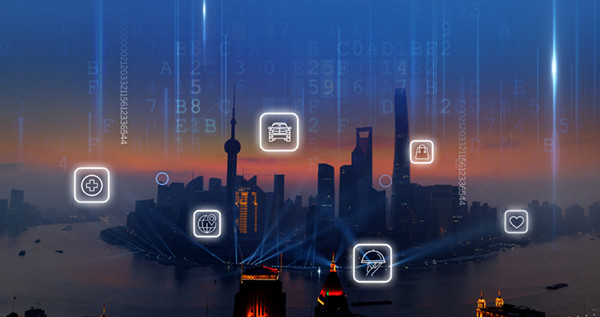Shanghai builds on its smart approach

Shanghai is rapidly developing digital urban management by introducing a series of smart systems that have transformed the provision of a range of services. [GAO ERQIANG AND ARTWORK BY LU PING/CHINA DAILY]
Digital urban management improves efficiency in metropolis
If a visitor to the Nanjing Building in downtown Shanghai opened a window and reached out to take a photograph of the area, security worker Fan Tianyu would receive an immediate alert on a smart bracelet.
He then would rush to the scene of the incident in the seven-story structure, which is nearly 100 years old and stands on the bustling Nanjing Road pedestrian street. Fan would tell the visitor to stop taking photos and close the window.
The bracelet is part of a smart system being used in the building to detect safety risks posed by objects that could fall on crowds of pedestrians below.
The system uses a range of advanced technologies, including big data, artificial intelligence and 5G, and is equipped with multilayer data and internet of things sensing abilities.
It assesses the building for visitor flow, fire prevention, noise levels, use of elevators and escalators, disinfection work and the efficiency of its water pipes.
The system produces reports that are like health checkups for the building around-the-clock.
Wei Tao, manager of the building, which is home to a flagship Huawei store and usually has many visitors, said the structure "undergoes digital observation in a dynamic way to enable real-time assessment, discovery and resolution of problems".
At the start of this year, Shanghai became the first city in China to issue a document covering the comprehensive promotion of its digital transformation.
In late February, a smart management trial launched jointly by the Shanghai Urban Operation Management Center and the Huangpu district government marked the first use of innovative digital urban management in one of the city's buildings.
Xu Huili, deputy director of the center, said that in a huge city like Shanghai, traditional methods such as allocating additional personnel to front-line administrative work frequently failed to detect problems and potential hazards quickly and deal with them properly.
Integration plan
Shanghai is home to a population of nearly 25 million, 47,500 tall buildings and more than 6 million vehicles.
"The city, which is a window for the world to observe China, is a pioneer in promoting urban digital transformation. It is also attempting to integrate social resources with the government's administrative resources to facilitate digital urban management, which helps improve governance capability in big cities and ultimately benefits residents," Xu said.
The Shanghai authorities have announced that 100 "innovative scenarios" involving the use of smart systems will be created in the near future to help urban management in office buildings, large supermarkets and commercial complexes.
Fan, the security worker, said that traditionally he and his colleagues had to patrol the Nanjing Building regularly to detect problems, such as bikes being left in front of the gates, boxes blocking fire rescue routes and people smoking outside designated areas.
However, the smart system, along with technological support from Huawei, now plays a big role in such work.
When a problem is detected, a warning signal flashes on a large screen in the district urban operations management center. After a security worker goes to the scene and deals with the incident, the warning is removed.
Wei said traditional manual patrols are not very efficient and cover a relatively small area, while the new approach offers more scientific and refined management.
He said the Nanjing Building has more than 80 sets of internet of things sensing facilities equipped to collect data in various areas to ensure safe operations.
For example, when the flow of pedestrians on Nanjing Road reaches a medium-risk level, the district urban operation management center issues a "large passenger flow warning" to retail outlets and the building's smart system sends a dispersal notice to the security manager.
A plan to control passenger flow is then activated. This includes setting up notice boards at store entrances and exits, limiting the number of people in a store, and only allowing them to enter or exit through specific doors, in order to ensure safety.
Xu said the introduction of such a novel system would trigger far-reaching innovation in urban intelligent management and services in the city, which is also home to a subway network totaling 729 kilometers and boasts 240,000 elevators and escalators.


 China's public holidays for 2025
China's public holidays for 2025  Shanghai FTZ: Go all out to build China's first pilot zone for Silk Road E-commerce cooperation
Shanghai FTZ: Go all out to build China's first pilot zone for Silk Road E-commerce cooperation  Favorable policies boost 'China Travel' trend
Favorable policies boost 'China Travel' trend  play
play 